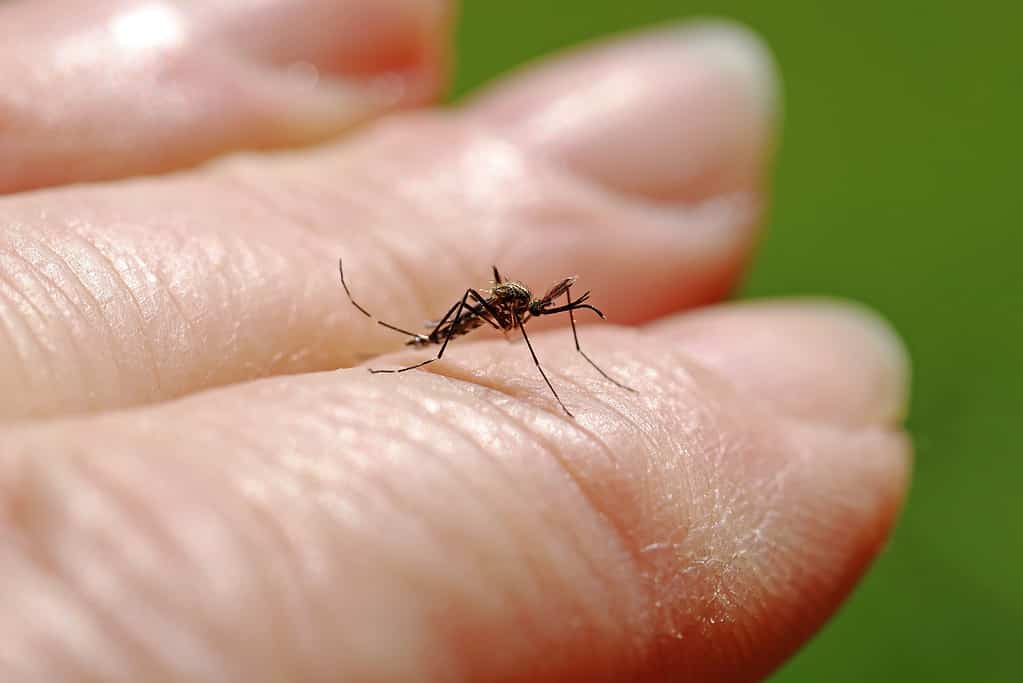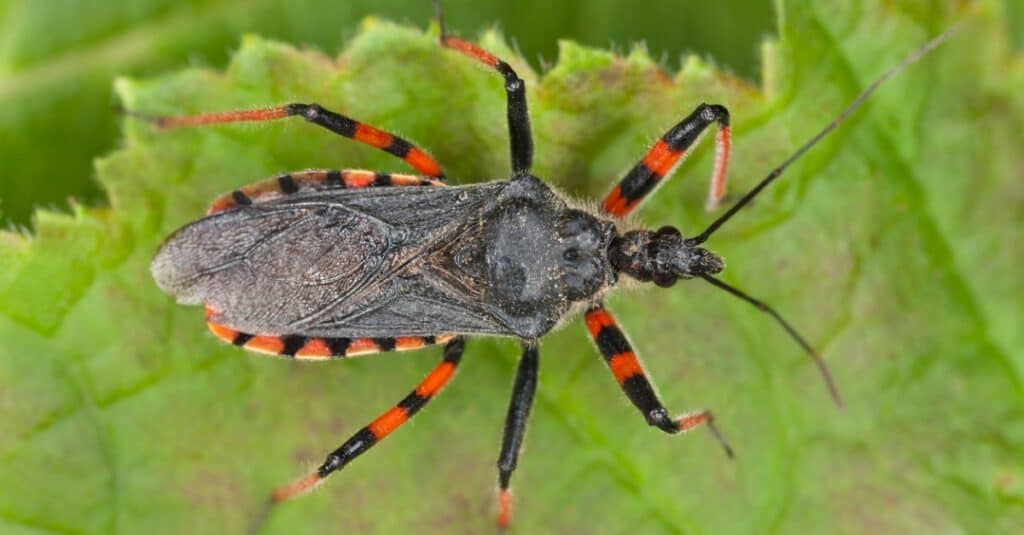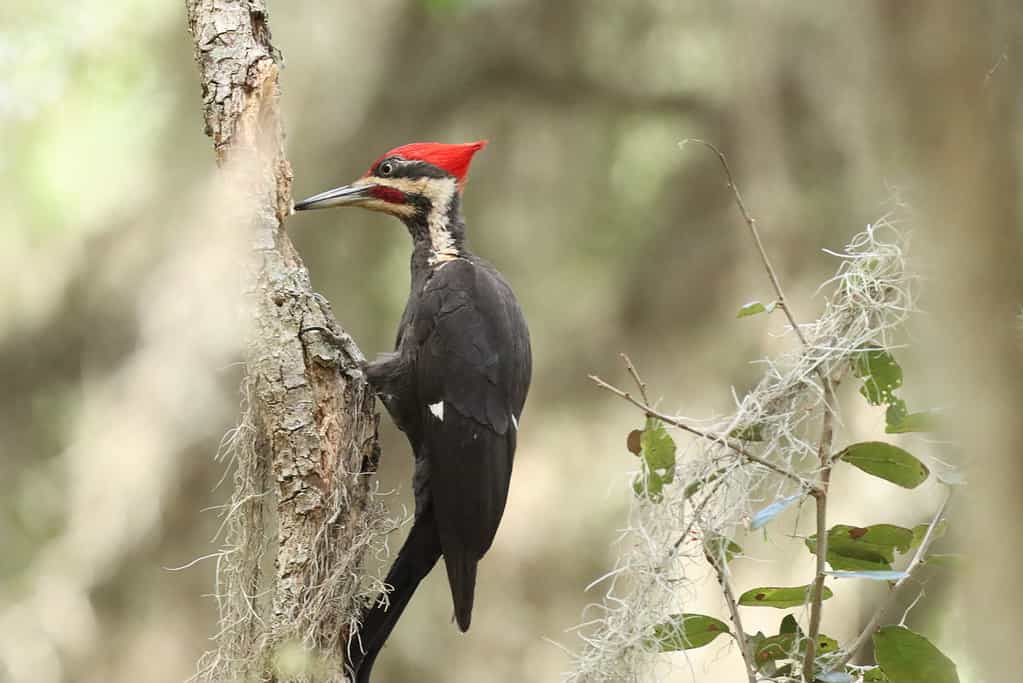New Jersey is home to a plethora of beautiful and unique wildlife. Although many of these critters can appear adorable and intriguing, did you know some pose a threat? There are plenty of flying animals in the Garden State that can not only harm the environment but also your health!
We’ve gathered the top eight animals with wings in the state that you should be aware of! Everything from deadly mosquitoes to nuisance birds. Let’s get started!
The Most Dangerous Flying Animals in New Jersey
1. Wasps

If you’re allergic to wasps, a sting from a Yellowjacket could be lethal.
©tasnenad/Shutterstock.com
Wasps are a group of insects with a poor track record for being aggressive, territorial, and hunting down humans. In New Jersey, many individuals refer to them as Yellow Jackets or Hornets.
So it makes sense that they are regarded as dangerous creatures! These stinging insects can cause exceptional pain when they sting you. Despite their aggressive nature and potential to become unpleasant picnic guests, wasps remain crucial pollinators.
Wasps like yellow jackets and hornets are typically far more hostile than the majority of bee species. When pursuing a meal or establishing their territory, they will swarm close to people and occasionally fly into us.
This is their way of telling us to get out of their area. Additionally, when they feel like you’re threatening them, they will happily sting you. Some persons may experience an allergic or anaphylactic reaction as a result.
2. Mosquitoes

There are over 3,000 species of mosquitos on the planet.
©Astrid860/ via Getty Images
Mosquitoes are possibly the most hazardous creatures in New Jersey, in spite of their minuscule size! All across the world, these tiny, blood-sucking critters are an annoyance. Some mosquitoes are simply just annoying, while others carry deadly diseases.
Mosquito species serve as the carriers of diseases like West Nile Virus, Zika, dengue fever, and malaria. Other species prey on domesticated animals or cattle, spreading diseases like Equine Encephalitis and heartworm that damage animals.
By eliminating or reducing the mosquito population, illnesses can be stopped at their source. In the near term, mosquitoes can be deterred and bites avoided by using mosquito nets, pesticides, and bug repellents.
3. Kissing Bugs

It can take 20 minutes for the kissing bug to fill up with blood.
©Henrik Larsson/Shutterstock.com
The moniker “kissing bugs” refers to the very unsettling practice of these bugs biting around the mouths of their victims. If that’s not bad enough, Trypanosoma cruzi, a parasite that causes Chagas disease, is carried by these insects.
A T. cruzi infection is curable in its initial stages but, if ignored, can result in a chronic condition that lasts a lifetime. Fever, exhaustion, discomfort in the body, migraines, hives, loss of appetite, loose stool, and vomiting are some of the disease’s initial signs and symptoms.
Cardiovascular problems including an enlarged heart and heart failure, as well as gastrointestinal issues like difficulties swallowing, digestive problems, and an inability to ingest solid food, are among the long-term ailments of Chagas disease.
There’s no denying why the kissing bug makes the list of the most dangerous flying animals in New Jersey
4. Greenhead Flies

The bite from these
horse
flies is incredibly painful.
©PlazacCameraman/iStock via Getty Images
Greenhead flies arrive on the shores of New Jersey around the middle of July. The Eastern North American coastal wetlands are home to greenhead flies, which get their name from their big, brilliant green eyes.
Mature horse flies use sweet foods to fuel themselves. During the period that they spend laying their eggs, female flies consume blood. It’s a lot like how female mosquitoes need blood.
The female flies are capable of attacking any nearby source, including people, animals, and other insects. Protein from the blood aids in the development of their eggs. The reason why female flies keep biting people is because they can see and smell them.
These flies are able to detect carbon dioxide when you breathe out. They pump their saliva into your bloodstream when these flies bite humans. The pain you experience from the bite is actually your body responding to a substance in the saliva that prevents your blood from clotting.
5. Bats

Little brown bats weigh less than an ounce.
©Peter Radosa/Shutterstock.com
In New Jersey, there are many bats, and they actively help to keep pesky insects under control. The large brown and tiny brown bats are two species that are frequently spotted in the area hibernating in groups inside of houses.
Solitary bats, another type of bat, rarely enter structures. The large brown bat, which is the bat most frequently tested for rabies, is responsible for almost 75% of bat encounters with humans and animals.
Throughout the warmer months of spring and summer, the little brown bat also becomes fairly prevalent in residences, and many of them hibernate in deserted iron mines. Fewer small brown bats have been discovered to be rabid and have been exposed to humans and other animals than big brown bats.
6. Spotted Lanternfly

These pests are so destructive that they’re making mainstream headlines.
©iStock.com/arlutz73
Another one of the most dangerous flying animals in New Jersey is the spotted lanternfly. Residents in the Garden State have seen these creatures everywhere! Areas with spotted lanternfly infestations and quarantines report hundreds of these bothersome insects.
They have a negative impact on the residents’ standard of life as well as their capacity to take advantage of nature in the warmer months of the year. Spotted lanternflies will swarm in the air, and blanket trees with their bodies, and their honeydew may smother any surface they touch.
The spotted lanternfly not only harms trees and lowers the quality of life, but it also poses a serious threat to New Jersey’s agricultural sector. Are spotted lanternflies harmful to you directly?
This pest is not dangerous to humans. They neither sting nor bite, yet spotted lanternflies can be quite dangerous to many different kinds of plants. They may additionally harm the landscape by releasing a slimy fluid that encourages the growth of black mold with soot.
7. Woodpeckers

Woodpeckers prefer to knock on dead trees.
©Wirestock/iStock via Getty Images
Most woodpecker characteristics have been modified to help in feeding on the outer edges of trees. Their hard, pointed beaks are ideal for chiseling away at tree bark to find bugs. Their four-inch-long tongue is coated in a material resembling adhesive, which makes it simpler to capture bugs after they find them.
In order to grasp onto trees, woodpeckers use their feet with a pair of toes facing forward and two backward. What makes these iconic birds a danger in New Jersey? Woodpeckers make a loud commotion and destroy wood by pounding or chipping at it.
Although they favor trees, woodpeckers have been known to attack houses as well. They do this to either mark their territory, consume bugs that reside in the siding, or entice a partner. Small, uneven holes are produced as a result, in addition to an irritating sound.
8. Pigeons

Some pigeons are so intelligent that have passed the mirror test!
©YIUCHEUNG/Shutterstock.com
Pigeons are prevalent birds that can frequently be seen in metropolitan cities with dense populations of people. Pigeons don’t have to migrate like other types of birds do. They don’t need to go looking for warmer regions in the winter because they can endure the chilly New Jersey winters.
Anywhere you see one pigeon, you can guarantee there are plenty more flying around the same region. Their sheer numbers can make it challenging to adequately deal with them. They also harbor a number of diseases that can be spread to people through their excretions, such as salmonellosis, histoplasmosis, and E. coli.
The likelihood of infection rises as the number of wild pigeons in a location increases.
Additionally, pigeon poop can harm a building’s structure. They can impair durability and appearance by eating away at the surface of whatever they’re on because of their acidity.
Their waste may jam gutters, which in turn leads to water overflowing and damaging property.
Summary of the Most Dangerous Flying Animals in New Jersey
| Rank | Flying Pest |
|---|---|
| 1 | Wasps |
| 2 | Mosquitoes |
| 3 | Kissing bugs |
| 4 | Greenhead flies |
| 5 | Bats |
| 6 | Spotted lanternfly |
| 7 | Woodpecker |
| 8 | Pigeon |
The photo featured at the top of this post is © Sarun T/Shutterstock.com
Thank you for reading! Have some feedback for us? Contact the AZ Animals editorial team.







